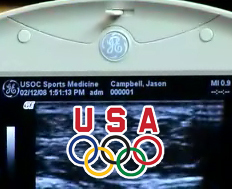by
Barbara Kram, Editor | April 07, 2008

The U.S. Olympic Committee
and GE announced two
health monitoring
research programs.
CHICAGO - In preparation for the Beijing 2008 Olympic Games, the U.S. Olympic Committee (USOC) and the General Electric Company (NYSE: GE), a Worldwide Partner of the Olympic Games, announced two research programs aimed at demonstrating that health monitoring and early intervention leads to injury prevention and enhanced health and sports performances for athletes.
The first program is a cardiac clinical research study with top U.S. Olympic athletes and hopefuls on the U.S. Men's Rowing and USA Weightlifting teams while the second initiative will monitor the musculoskeletal health of athletes competing for USA Weightlifting, USA Boxing, USA Wrestling and the U.S. Soccer Women's National Team. These two studies are continuations from research programs at the Torino 2006 Olympic Winter Games.
"Every day an Olympic athlete spends in rehab is a day lost in training, making earlier injury diagnosis and real-time recovery monitoring crucial for elite performance,'' said Dr. Michael Reed, U.S. Olympic Committee Medical Director, Performance Services Division. ''It is increasingly important that as a National Olympic Committee, we have the most innovative tools to help predict, diagnose, treat and monitor sports injuries earlier to ensure a quick return to play. It's my belief that GE's ultrasound technology will become a standard tool in healthcare for athletes.''




Ad Statistics
Times Displayed: 19090
Times Visited: 362 Stay up to date with the latest training to fix, troubleshoot, and maintain your critical care devices. GE HealthCare offers multiple training formats to empower teams and expand knowledge, saving you time and money
Cardiac Research Program Set to Build Off Results from Torino
A clinical study of USA Weightlifting and U.S. Men's Rowing, led by Dr. Malissa Wood, of the Massachusetts General Hospital Heart Center (MGH) in Boston, will use GE's Vivid i - an advanced, miniaturized cardiovascular ultrasound system - to examine athletes' hearts pre- and post- competition to learn more about the function and performance of highly-conditioned hearts.
The study is ongoing for Dr. Wood, who also partnered with the USOC and GE Healthcare by studying the hearts of U.S. Short Track Speedskaters for the Olympic Winter Games in Torino. The results from the study thus far have indicated that there are specific changes in heart function that correlate to different levels of training.
According to Wood and Dr. Michael Picard from MGH, results of their Torino study proved "participation by world-class speedskaters in a vigorous training regimen results in cardiovascular anatomic and physiologic adaptations. These changes, including cardiac chamber dilatation, enhanced ventricular diastolic function and attenuated resting right ventricle systolic function, are likely adaptive and allow for more efficient energy use at rest and a robust response to demands of exercise. In other words, these athletes had an enlargement of the cavities of the heart and better function of the heart compared to others that are the same age and gender."

